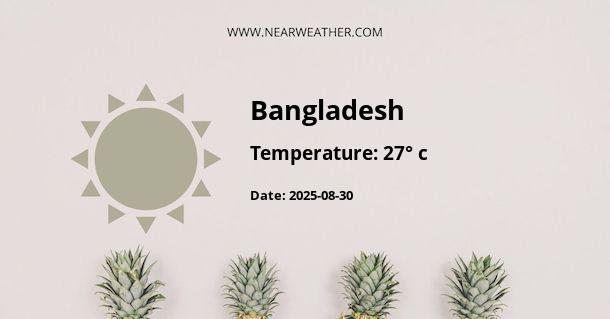The Climate and Weather in the People’s Republic of Bangladesh (BD)
Bangladesh, officially known as the People’s Republic of Bangladesh, is a country located in South Asia. It is known for its diverse culture, vibrant cities, and beautiful landscapes. One important aspect of this country is its climate and weather, which vary throughout the year. Understanding the climate patterns is essential for tourists, business travelers, and residents alike. In this article, we will explore the climate and weather conditions in Bangladesh throughout the year.
Geographical Factors
Before delving into the specifics of Bangladesh's climate, it is important to understand the geographical factors that influence its weather patterns. Bangladesh is a low-lying country, situated in the Bengal Delta, with a diverse topography that includes rivers, hills, and coastal areas. This geographical diversity plays a significant role in shaping the country's climate.
Monsoon Climate
Bangladesh experiences a monsoon climate, characterized by distinct wet and dry seasons. The country receives heavy rainfall during the monsoon season, which lasts from June to October, due to the influence of the southwest monsoon winds from the Bay of Bengal. This period is known for its high humidity and frequent downpours.
The monsoon rains are vital for Bangladesh's agriculture, as they provide water for crops and replenish the country's rivers and reservoirs. However, excessive rainfall during this season can also lead to flooding in low-lying areas, causing significant challenges for the people and infrastructure.
Winter Season
The winter season in Bangladesh lasts from November to February and is relatively dry and mild. During this period, the weather is characterized by cool temperatures, especially in the northern and central regions of the country. The average temperature ranges from 10°C (50°F) to 20°C (68°F) during this season.
Although the winter season is considered the dry season, occasional rainfall can still occur. However, the amount of rainfall is significantly lower compared to the monsoon season. This season is popular among tourists, as the weather is pleasant and ideal for outdoor activities.
Summer Season
The summer season in Bangladesh, which lasts from March to May, is characterized by hot and humid weather. The temperature during this season can rise up to 40°C (104°F) in some parts of the country, particularly in the southwestern region.
The high temperatures and humidity levels during the summer season can make it uncomfortable for outdoor activities. It is advisable to stay hydrated and seek shade during the hottest parts of the day. The coastal areas, such as Cox's Bazar and Saint Martin's Island, offer some respite with sea breezes providing a cooling effect.
Regional Variations
Due to its geographical diversity, Bangladesh experiences regional variations in climate and weather. Here are some notable regional differences:
1. Coastal Areas:
The coastal areas of Bangladesh, including Cox's Bazar and the Sundarbans, experience a maritime climate. The temperatures here are relatively moderate throughout the year, with high humidity. The coastal regions also receive higher rainfall compared to other parts of the country.
2. Northern Region:
The northern region of Bangladesh, including cities like Rajshahi and Rangpur, experiences a subtropical climate. Winters in this region can be colder compared to other parts of the country, with temperatures sometimes dropping below 10°C (50°F). The summer season in the north is characterized by hot and humid weather, similar to the rest of the country.
3. Hill Tracts:
The hilly regions of Bangladesh, such as Bandarban and Rangamati, have a different climate compared to the rest of the country. These areas experience a more temperate climate, with cooler temperatures throughout the year. The hill tracts also receive higher rainfall, making them lush and green.
Extreme Weather Events
Bangladesh is prone to various extreme weather events, including cyclones, floods, and droughts. The low-lying nature of the country, coupled with climate change factors, makes it vulnerable to these natural disasters.
Cyclones, often originating in the Bay of Bengal, can cause significant damage to coastal areas. The government of Bangladesh has taken several measures to improve cyclone preparedness and minimize the impact of these events.
Flooding is another major concern in Bangladesh, especially during the monsoon season. The country's extensive river network, coupled with heavy rainfall, often leads to inundation of low-lying areas. Efforts are underway to improve flood management systems and protect vulnerable communities.
Conclusion
The climate and weather conditions in the People’s Republic of Bangladesh vary throughout the year, influenced by its geographical factors and the monsoon climate. Understanding these patterns is crucial for planning trips, agricultural activities, and disaster preparedness. Whether it's enjoying the pleasant winter weather, enduring the hot and humid summers, or witnessing the beauty of the coastal regions, Bangladesh offers a diverse climate that adds to its rich cultural and natural heritage.
A - Bangladesh's Latitude is 24.000000 & Longitude is 90.000000.
A - Weather in Bangladesh is 16° today.
A - Climate Conditions in Bangladesh shows clear sky today.
A - Humidity in Bangladesh is 36% today.
A - Wind speed in Bangladesh is 8.42 km/h, flowing at 318° wind direction. today.
